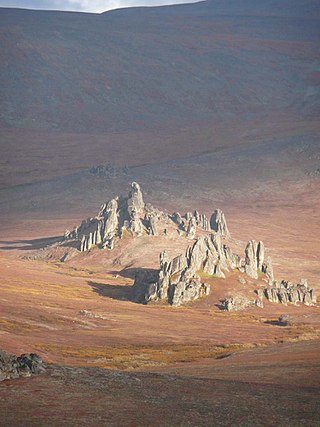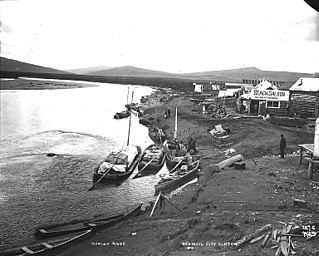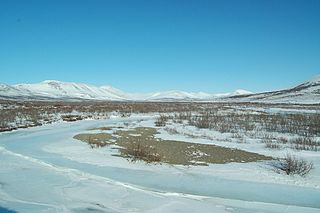Related Research Articles

Nome is a city in the Nome Census Area in the Unorganized Borough of the US state of Alaska. The city is located on the southern Seward Peninsula coast on Norton Sound of the Bering Sea. It had a population of 3,699 recorded in the 2020 census, up from 3,598 in 2010. Nome was incorporated on April 9, 1901. It was once the most-populous city in Alaska. Nome lies within the region of the Bering Straits Native Corporation, which is headquartered in Nome.

The Koyuk River is a river on the Seward Peninsula of western Alaska, in the United States. The river originates in the interior of the peninsula, at the Lost Jim Lava Flow of the Bering Land Bridge National Preserve, where it flows southeast towards the mouth of Norton Bay on Norton Sound. The native village of Koyuk is located at its mouth. The two major tributaries are the Peace and Salmon rivers; other tributaries include Dime and Sweepstakes.

The Fish River is a waterway in the U.S. state of Alaska. The 47-mile-long (76 km) river rises in the Bendeleben Mountains and flows south to Golovnin Lagoon, before emptying into Golovnin Bay, Norton Sound, and the Bering Sea. The basin formed by the Fish River is known for its placer gold deposits, and in particular, the Niukluk River and its tributaries; production from this tributary valley is reported to be more than from any other place in the region. A galena mine existed 40 miles (64 km) from the sea, worked on occasion by a San Francisco corporation with a few hundred tons of ore taken to the city for smelting and refining for silver. Walter Curran Mendenhall found obscure fossils on Fish River at White Mountain.
The Tubutulik River is a waterway in the U.S. state of Alaska. The 25-mile (40 km) long river is situated on the Seward Peninsula. It flows southeastwards to the Kwiniuk Inlet at the northwestern end of Norton Bay, 25 miles (40 km) southwest of Koyuk in the Bering Sea. Its Inuit name was reported as "Tubuktulik" in 1849 by Capt. Mikhail Dmitrievich Tebenkov of the Imperial Russian Navy. Exploration for placer gold occurred in the Council district area where the river valley is located, and in 1898, mining commenced. The production was substantial and ranked second only to that of Nome.

Cape Nome is a headland on the Seward Peninsula in the U.S. state of Alaska. It is situated on the northern shore of Norton Sound, 15 miles (24 km) to the east of Nome also on Norton Sound. It is delimited by the Norton Sound to the south, Hastings Creek on the west, a lagoon on the east and an estuary formed by the Flambeau River and the Eldorado River. From the sea shore, Cape Nome extends inland by about 4 miles (6.4 km), connected by road with Nome.

Niukluk River is a waterway in the U.S. state of Alaska. It rises in the Bendeleben Mountains and, after flowing across a broad valley lowland for about 15 miles (24 km), enters a narrower valley, in which it flows for about 20 miles (32 km). Below the mouth of Melsing Creek, the valley broadens out and merges with that of Fish River, to which the Niukluk is a tributary. It receives many tributaries, of which the Koksuktapaga, joining it from the south, is the largest. In Niukluk River itself, gold was found at its head, though most abundant below the mouth of American Creek. Just below the mouth of Ophir Creek, a little gold has been rocked out on the bars. The broad gravel flood plain in this part of the basin is said to be auriferous. Below the mouth of Ophir Creek the river has cut a small rock canyon 50 feet (15 m) below an old valley floor, leaving broad benches on either side. These benches are sheeted over by a few feet of gravel.
Klokerblok River is a waterway in the U.S. state of Alaska, near Nome. This river rises a few miles from the coast, north of Cape Topkok. It flows in an easterly direction, and joins Fish River in its delta mouth. Front the upper end of Golofnin Sound, a broad depression extends inland, which includes the lower parts of the valleys of Fish, Klokerblok, and Niukluk Rivers. Except for a 50-foot (15 m) gravel terrace on the western side of Golofnin, there are few, if any, terraces or benches in this area.
Eldorado River is a waterway on the Seward Peninsula in the U.S. state of Alaska. It is situated 14 miles (23 km) west of Solomon. This river has its source within a few miles of Salmon Lake, from which it is separated by a low divide. It flows southeast through a broad gravel-filled valley for 30 miles (48 km) to Flambeau River before emptying into Safety Sound. Its headwaters reach the limestones of the Nome series and much of its course lies in a chlorite-albite-schist belt. The Eldorado River provides a southerly drainage into the Bering Sea.
Flambeau River is a waterway on the Seward Peninsula in the U.S. state of Alaska. It has a broad, basin-shaped valley, and terminates as a tributary to Safety Sound. Its name is first recorded by Edward Chester Barnard of the United States Geological Survey (1900). The nearby gold prospect deposit site, "Flambeau River", is named after the waterway.
Mint River is a waterway in the U.S. state of Alaska. It rises in the York Mountains, north of the source of the Anikovik River. It reaches the ocean through Lopp Lagoon that extends about 20 miles (32 km) to the east from Cape Prince of Wales. In its upper course, it has a narrow valley. Near the sea, it winds for about 10 miles (16 km) across the tundra.
Anikovik River is a waterway in the U.S. state of Alaska. It heads in the York Mountains about 15 miles (24 km) from the Bering Sea. As it leaves the mountains, it has a westerly course, but bending sharply to the south, it flows in that direction to the sea. It has a broad, flat flood plain, from 300 feet (91 m) to 0.5 miles (0.80 km) in width. In the upper part of its course, the river flows in greenstones, but below its bend, to the south, it cuts phyllites and slates. A rough estimate of the fall of river makes it about 15–18 feet (4.6–5.5 m) per mile. Buhner Creek joins Anakovik River about 2 miles (3.2 km) above the mouth of Deer Creek.

York Mountains are located on the Seward Peninsula in the U.S. state of Alaska. They extend inland from the Bering Sea to the rocky cape of the same name. On the seaward sides, the streams have incised canyon-like valleys. Eastward, the York Mountains are extended by the highlands lying north of Port Clarence. Their western flanks fall off rather abruptly to the York PIateau. The general aspect of these mountains is rugged. The York Mountains and several other highland masses form isolated groups in the northern half of the peninsula, while in the southern half of the peninsula, the Kigluaik, Bendeleben, and Darby mountains form a broken range along a crescentic axis.
Bonanza River (Inupiaq: Kiwaliq) is a waterway on the Seward Peninsula in the U.S. state of Alaska. The headwaters lie close to Venetia Creek and the Koksuktapaga River. It flows southeast for 25 miles (40 km) before reaching Safety Sound, as do the Flambeau and Eldorado Rivers, and then through Safety Inlet to Norton Sound. The village of Solomon is approximately 2 miles (3.2 km) away. Across the divide of West Creek, in the Bonanza River drainage, and lying above the West Creek schists, is a series of green chloride schists and sills of greenstone; these chloritic schists are the prevailing rocks of the divide between Eldorado and Bonanza rivers. In its general character, it is similar to the Eldorado River. Also called Bonanza Cal, later maps indicate California Creek to be a principal tributary of Bonanza River. According to Alfred Hulse Brooks, the Eskimo name is Ki-ul-uk.

Nome River is a waterway on the Seward Peninsula in the U.S. state of Alaska. It has its source in a narrow valley in the southern margin of the Kigluaik Mountains, 4.5 miles (7.2 km) west of Salmon Lake.
Pinguk River is a waterway located on the Seward Peninsula in the U.S. state of Alaska. The river runs in a northwesterly direction for 34 miles (55 km) and then flows into the Arctic Lagoon about 30 miles (48 km) northeast of Cape Prince of Wales.
Cape Mountain (Inupiaq: Kiŋigin) is located 3 miles (4.8 km) southeast of Cape Prince of Wales on the Seward Peninsula in the U.S. state of Alaska. It was named by the surveyor, Alfred Hulse Brooks, in 1900.
York Plateau is located on the Seward Peninsula of the U.S. state of Alaska. It is situated beyond the western front of the York Mountains. It is a dissected plateau which stands at an elevation of about 600 feet (180 m). The top of the plateau is smooth and hard. The larger streams within the plateau have rather broad valleys, which are cut down nearly to sea level, while the smaller tributaries flow in canyons. To the south, the plateau ends in a steep escarpment which is separated from the Bering Sea by a narrow coastal plain or beach. Near the settlement of York, the coastal plain has an elevation of about 50 feet (15 m), and above this is a higher bench at about 400 feet (120 m), which is similar to the plateau in character, but not so extensive. The plateau seems to slope more gradually to the Arctic Ocean, from which it is separated by a coastal plain which extends inland for several miles. A wide lagoon separates this coastal plain from the Arctic Ocean. The surface of the plateau is covered with a thin layer of semiangular gravels.
Bluestone River is a waterway located on the Seward Peninsula in the U.S. state of Alaska. A tributary of the Tuksuk Channel from the south, Bluestone is a north-flowing stream situated 11 miles (18 km) southeast of Teller. It was named in 1900 by Edward Chester Barnard, topographer of the United States Geological Survey.

Grantley Harbor is a waterway located at the bay of Port Clarence, Alaska, on the Seward Peninsula in the U.S. state of Alaska. The inner harbor at the entrance to the northeast corner of the bay was named after Lord Grantley.

Bluff, also known as Agookauchuk, was a 20th-century mining town in Nome Census Area, Alaska. It was built at the mouth of Daniels Creek on the north shore of Norton Sound on the Seward Peninsula in the summer of 1900, as a result of the Nome Gold Rush. The town was located 55 miles (89 km) southeast of Nome. The settlement was served by a post office for eighteen years, from 1901 to 1919.
References
 This article incorporates text from this source, which is in the public domain : U.S. Geological Survey's "Reconnaissances in the Cape Nome and Norton Bay regions, Alaska, in 1900" (1901)
This article incorporates text from this source, which is in the public domain : U.S. Geological Survey's "Reconnaissances in the Cape Nome and Norton Bay regions, Alaska, in 1900" (1901) This article incorporates text from this source, which is in the public domain : M. Baker's "Geographic dictionary of Alaska" (1906)
This article incorporates text from this source, which is in the public domain : M. Baker's "Geographic dictionary of Alaska" (1906)
- ↑ Geological Survey (U.S.); Alfred Hulse Brooks; Arthur James Collier; Walter Curran Mendenhall; George Burr Richardson (1901). Reconnaissances in the Cape Nome and Norton Bay regions, Alaska, in 1900. Government Printing Office. pp. 69–. Retrieved March 30, 2013.
- ↑ Geological Survey (1901), p. 138
- ↑ Baker, Marcus (1906). Geographic dictionary of Alaska (Public domain ed.). Govt. Print. Off. pp. 686–. Retrieved March 30, 2013.
- ↑ Lynette Iezzoni's Influenza 1918: The Worst Epidemic In American History, pg 167.
- ↑ "Ghost towns scattered across Alaska map | Geophysical Institute". www.gi.alaska.edu. Retrieved May 9, 2023.
65°29′38″N167°41′02″W / 65.494°N 167.684°W
